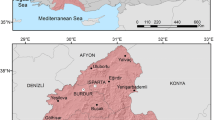Abstract
Several approaches have been named in earlier articles regarding the problem of plant selection and recommendation. Unfortunately, these methods are ineffective in achieving successful plant selection and recommendations for high performance. To solve this issue, a competent Region Centric Multi Feature Growth Analysis Model (RMFGAM) is presented in this paper. The model considers different features like CFSI (Climate–Fluid–Soil–Industry) towards the problem. Also, the model preprocesses the available plant traces and extracts such features. Further, the traces are grouped and based on the features being extracted, the model applies climate centric plant growth analysis, fluid centric plant growth analysis, soil centric plant growth analysis and industry centric plant growth analysis. Each analysis measures influence of such features in regional manner. Using the influence measures computed, the method computes the plant selection weight for various plants. Based on the plant selection weight, the plants are selected and ranked to produce the recommendation. The proposed method develops the performance of plant selection and recommendation.




Similar content being viewed by others
Data Availability
The dataset generated and analyzed during the current study are available from the corresponding author on reasonable request.
References
van Klompenburg T, Kassahun A, Catal C. Crop yield prediction using machine learning: a systematic literature review. Comput Electr Agric. 2020;177: 105709. https://doi.org/10.1016/j.compag.2020.105709.
Shook J, Gangopadhyay T. Crop yield prediction integrating genotype and weather variables using deep learning. J Pone. 2017;16:e252402.
Kavita M, Mathur P. Crop yield estimation in india using machine learning. IEEE Int Conf Comput Commun Autom (ICCCA). 2020. https://doi.org/10.1109/ICCCA49541.2020.9250915.
Haki S, Wang L, Archontoulis SV. A CNN-RNN framework for crop yield prediction. Front Plant Sci. 2020;10:1750. https://doi.org/10.3389/fpls.2019.01750.
Pallavi K, Pallavi P, Shrilatha S, Sushma, Sowmya S. Crop yield forecasting using data mining. Glob Trans Proc. 2021. https://doi.org/10.1016/j.gltp.2021.08.008.
Bhagyashree L. Crop yield prediction in smartfarm agriculture system for farmers using IoT. Int J Adv Sci Technol. 2020;29(7):5165–75.
Khalid AA-G. Prediction of potato crop yield using precision agriculture techniques. PLoS ONE. 2016;11(9):2219. https://doi.org/10.1371/journal.pone.0162219.
Sujatha R, Isakki P. A study on crop yield forecasting using classification techniques. Int Conf Comput Technol Intell Data Eng. 2016. https://doi.org/10.1109/ICCTIDE.2016.7725357.
Singh R, Srivastava S, Mishra R. AI and IoT based monitoring system for increasing the yield in crop production. Int Conf Electr Electr Eng (ICE3). 2020. https://doi.org/10.1109/ICE348803.2020.9122894.
Swarupa Rani A. The impact of data analytics in crop management based on weather conditions. Int J Eng Technol Sci Res. 2017;4:299–308.
Jain N, Kumar A, Garud S, Pradhan V, Kulkarni P. Crop selection method based on various environmental factors using machine learning. Int Res J Eng Technol (IRJET). 2017;4(02):551–8.
Yang MD, Tseng HH, Hsu YC, Tseng WC. Real-time crop classification using edge computing and deep learning. In: 2020 IEEE 17th Annual Consumer Communications & Networking Conference (CCNC), 2020, pp. 1–4.
Bhimanpallewar R, Narasinagrao MR. A machine learning approach to assess crop specific suitability for small/marginal scale croplands. Int J Appl Eng Res. 2017;12(23):13966–73.
Ertina SB, Muhammad Z, Zulkifly N, Sutarman. Forcasting plant growth using neural network time series. In: 2019 International Conference of Computer Science and Information Technology (ICoSNIKOM), 2019, pp. 1–5.
Hewage P, Trovati M, Pereira E, et al. Deep learning-based effective fine-grained weather forecasting model. Pattern Anal Appl. 2021;24:343–66. https://doi.org/10.1007/s10044-020-00898-1.
Dhivya E, Durairaj-Vincent PM. Crop yield prediction using deep reinforcement learning model for sustainable agrarian applications. IEEE Access. 2020. https://doi.org/10.1109/ACCESS.2020.2992480.
Nevavuori P, Narra N, Lipping T. Crop yield prediction with deep convolutional neural networks’. Comput Electron Agric. 2019;163:104859.
Kamilaris A, Prenafeta-Boldú FX. Deep learning in agriculture: a survey. Comput Electron Agric. 2018;147:7090.
Rehman TU, Mahmud S, Chang YK, Jin J, Shin J. Current and future applications of statistical machine learning algorithms for agricultural machine vision systems. Comput Electron Agric. 2019;156: 585605.
RaghavendraNayaka P, Ranjan R. An efficient framework for algorithmic metadata extraction over scholarly documents using deep neural networks. SN Comput Sci. 2023;4:341. https://doi.org/10.1007/s42979-023-01776-3.
Kumble L, Patil KK. Evalutionary STBD model for bio-signal compression provisioning in wire-less sensor network. Int Conf Smart Technol Smart Nation. 2017. https://doi.org/10.1109/SmartTechCon.2017.8358634.
RaghavendraNayaka P, Ranjan R. An efficient framework for metadata extraction over scholarly documents using ensemble CNN and BiLSTM technique. Int Conf Innov Technol (INOCON). 2023. https://doi.org/10.1109/INOCON57975.2023.10101029.
Kumble L, Patil KK. An improved data compression framework for wireless sensor networks using stacked convolutional autoencoder (S-CAE). SN Comput Sci. 2023;4:419. https://doi.org/10.1007/s42979-023-01845-7.
Funding
No funding received for this research.
Author information
Authors and Affiliations
Corresponding author
Ethics declarations
Conflict of Interest
No conflict of interest.
Additional information
Publisher's Note
Springer Nature remains neutral with regard to jurisdictional claims in published maps and institutional affiliations.
This article is part of the topical collection “Advances in Computational Approaches for Image Processing, Wireless Networks, Cloud Applications and Network Security” guest edited by P. Raviraj, Maode Ma and Roopashree H R.
Rights and permissions
Springer Nature or its licensor (e.g. a society or other partner) holds exclusive rights to this article under a publishing agreement with the author(s) or other rightsholder(s); author self-archiving of the accepted manuscript version of this article is solely governed by the terms of such publishing agreement and applicable law.
About this article
Cite this article
Bommi, K., Evanjaline, D.J. & Kumar, K.M. Region Centric Multi Feature Growth Analysis Model for Efficient Plant Selection and Recommendation. SN COMPUT. SCI. 4, 810 (2023). https://doi.org/10.1007/s42979-023-02259-1
Received:
Accepted:
Published:
DOI: https://doi.org/10.1007/s42979-023-02259-1




